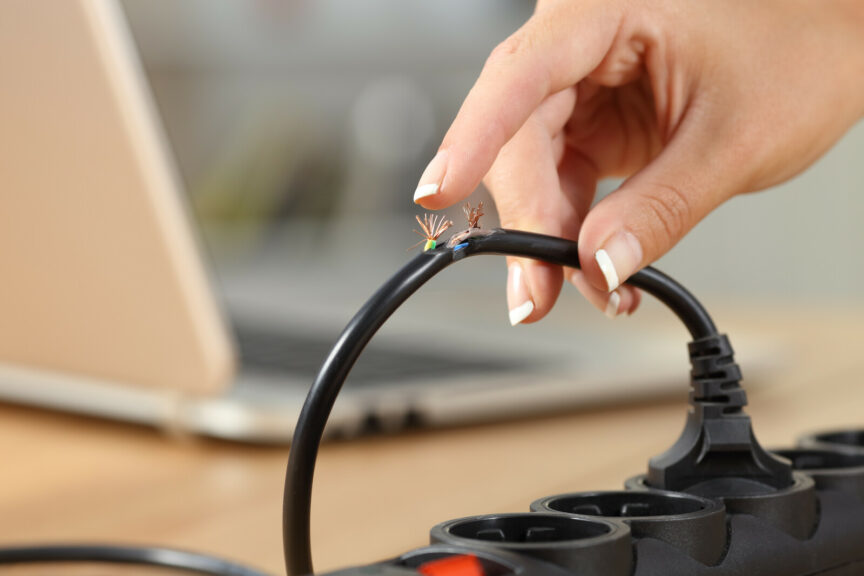By Arden Moore
Pro Pet Hero Instructor Director and Master Pet First Aid/CPR Instructor
I have finally got into the habit of always storing my pricey Bose earbuds I plug into my cell phone in the top drawer of my desk each and every time I finish a phone call. And, the long, skinny cords from my expensive tripod camera lights are encased in pet chew-proof casings. Same goes for the cords for my mounted television and desktop computer.
In a way, I guess I need to thank my cat, Casey and my dog, Kona for these preventive measures. Both have ‘bit’ me in the wallet by chewing on connection cords left unprotected in my backyard office. Fortunately, neither got electrocuted by chomping into live cords.
According to my emergency medicine veterinarian colleagues, felines and canines under age two represent that group of pets most likely to view electrical cords as tempting chew toys, but any pet of any age can bite and sever electrical cords if left unsupervised.
Let’s look at the consequences. Topping the list is a biggie: electrocution. That jolt of an electrical current can cause internal and external injuries. These include what is called electrothermal burns – the greyish or yellowish colors on a pet’s mouth, gums, lips or tongue. And, the electrical current can also travel inside the body and do damage to internal organs.
Watch Out for These Injury Signs
Common symptoms of a pet who has been electrocuted, depending on the severity, can range from:
* Vomiting
* Coughing
* Crying out in pain
* Excessive drooling or white foam coming out the mouth and/or nose
* Burn marks on the mouth, tongue, face and whiskers
* Persistent pawing of their mouth or rubbing their mouth across a rug or side of a sofa
* Uncontrollable muscle spasms
* Notable cracking sounds in the lungs
* Seizures
* Death
If you see your pet chew a cord and display any of these symptoms, immediately turn off the fuse box or circuit breaker to stop the electrical current. Do not simply pull the power cord from the outlet because you can accidentally be electrocuted.
Once the power has been cut off, you can then render pet first aid on the scene to your pet. Be sure to check his pulse and respiratory rates and check to see if his airway is clear. If your pet has stopped breathing, you need to do sets of cardiopulmonary resuscitation and rescue breathing. We at Pro Pet Hero recommend you do six sets and then call the nearest veterinary clinic on speakerphone and continue with the CPR sets as you quickly tell them what has happened and how many minutes you estimate you are from their clinic so that they can be alerted and be ready when you arrive.
Get into the Pet-Proofing Habit
As we enter a new year, let’s remind ourselves of the importance of doing regular room-by-room inspections to identify and to remove any potential pet danger. That means not leaving human medicine bottles on kitchen counters or any linear objects that can cause choking, such as dental floss, needle and sewing thread and shoelaces, within reach of a curious pet.

For dogs, you can soothe their need to chew by offering them safe chew toys, such as Kongs stuffed with peanut butter or cheese or tough Tuffy toys made with multiple layers of fabric and reinforced stitching. You can also work their brain by teaching and reinforcing with small, healthy treats the “leave it” cue.

Good luck convincing a cat to sit and stay. But you can keep your feline friend safe by making sure any tempting dangling cords are encased and kept out of view and paws’ reach. Consider spritzing cords with citronella as cats detest the smell of citrus.
So, get into the habit of regularly pet-proofing each room in your house. This is one of the best ways to protect your pet against electrocution as well as choking or eating any toxins.
I welcome Kona, Casey and my other pets to hang out with me in my backyard office, now that I have made sure any cord is safely out of their reach.
Learn Pet First Aid
Learn more on ways to keep your cats and dogs safe by visiting http://www.propethero.com. Consider taking our veterinarian-approved online pet first aid/CPR course. Enter this code: CPR – ARDEN MOORE and receive a 10 percent discount! And, if you are interested in becoming a Pro Pet Hero instructor, please click on the BECOME AN INSTRUCTOR button on the home page for more details.

